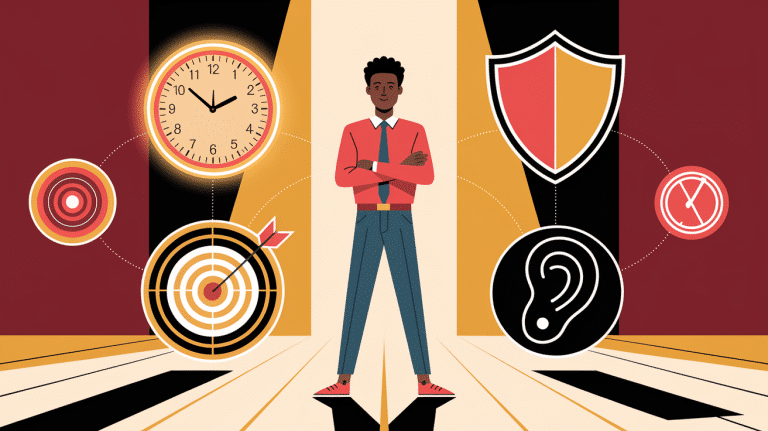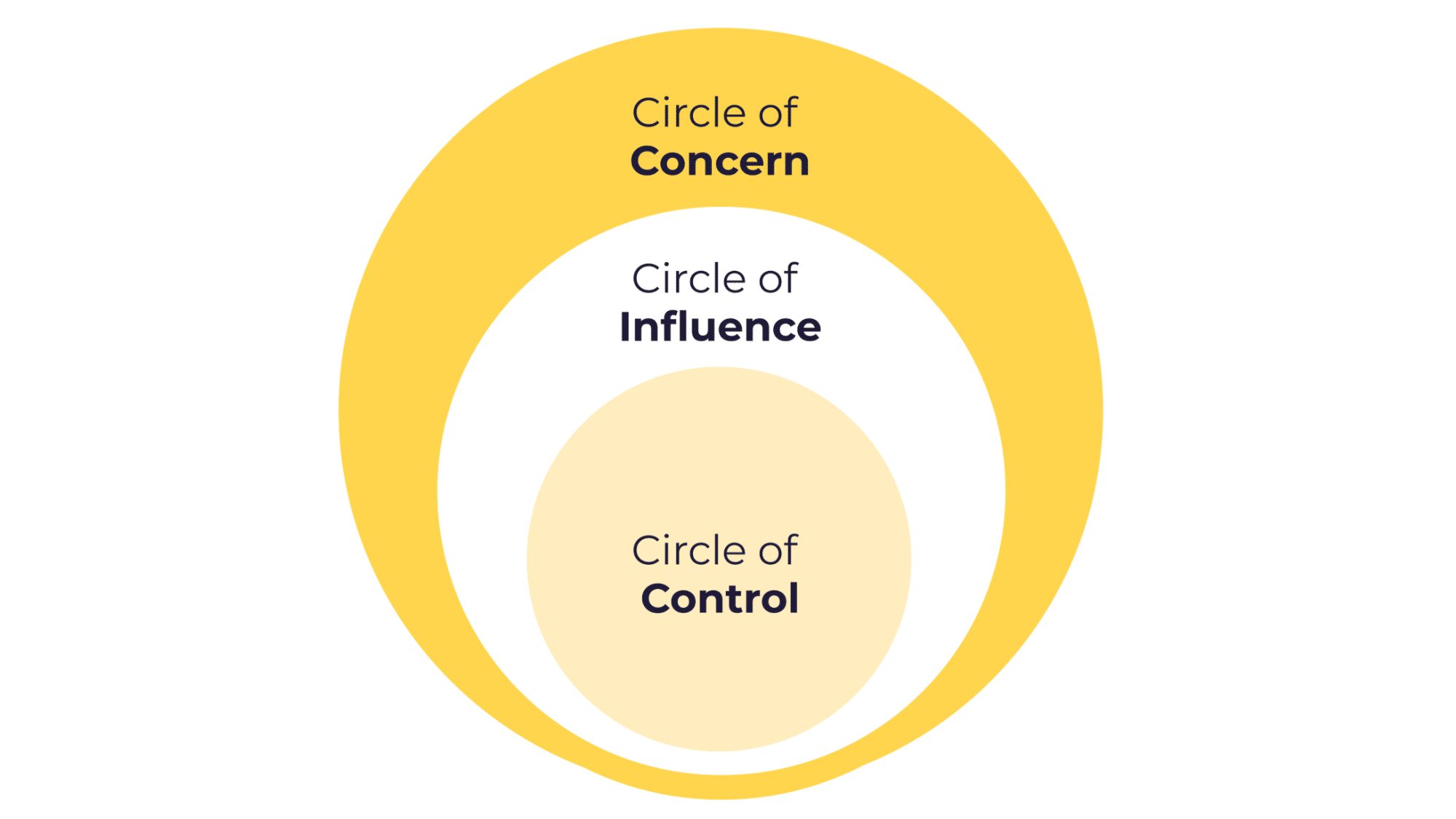What if I told you that 80% of your stress comes from worrying about things you’ll never be able to change?
You spend countless hours worrying about things you cannot control, the economy, other people’s opinions, or global events.
This constant focus on problems beyond your reach creates stress and leaves you feeling powerless in your own life.
Stephen Covey’s Circle of Influence concept offers a simple yet powerful solution.
By learning to distinguish between what you can control and what you cannot, you’ll reduce stress, increase productivity, and take charge of your personal growth.
This guide will show you exactly how to identify your Circle of Influence versus your Circle of Concern, apply these concepts in daily situations, and avoid common mistakes that keep people stuck in worry cycles.
What is Stephen Covey’s Circle of Influence?
Stephen Covey’s Circle of Influence represents all the things in your life that you can directly control and change. Think of it as your personal zone of power, the space where your actions make a real difference.
This circle includes your behavior, attitude, responses, daily habits, work performance, and communication style.
When you focus your energy here, you see immediate results. You can choose to exercise regularly, learn new skills, or improve your work quality.
The beauty of this circle lies in its potential for growth. As you consistently take positive action in areas you can control, your influence naturally expands. People notice your reliability, your skills improve, and new opportunities arise.
For example, you cannot control if your boss gives you a promotion, but you can control the quality of your work and professional relationships.
What is the Circle of Concern?
The Circle of Concern includes everything you worry about but can’t directly control. It surrounds your Circle of Influence and represents external factors affecting your life beyond your reach.
Key areas within your Circle of Concern include:
- Weather conditions and natural disasters
- Economic conditions and market changes
- Other people’s opinions and decisions
- Government policies and regulations
- Company decisions are made by leadership
- Global events and world affairs
The problem occurs when you focus excessively on your Circle of Concern, leading to stress, anxiety, and helplessness. You become reactive, worrying about unchangeable things.
For instance, you cannot control if it rains on your wedding day, but you can control having a backup plan in place. You cannot control stock market changes, but you can control your investment choices.
Key Differences Between the Circle of Influence & the Circle of Concern
Understanding the clear distinction between these two circles is essential for effective personal management and stress reduction.
| Circle of Influence | Circle of Concern |
|---|---|
| Things you can directly control | Things you worry about but cannot control |
| Your actions, habits, and responses | Weather, economy, others’ opinions |
| Leads to empowerment and growth | Creates stress and helplessness |
| Requires proactive behavior | Promotes reactive behavior |
| Expands when you focus on it | Shrinks your influence when overemphasized |
| Immediate results from efforts | No direct results from worrying |
| Builds confidence and capability | Drains energy and motivation |
| Examples: Work quality, health choices | Examples: Government policies, market trends |
When you focus primarily on your Circle of Influence, you take control of your life and see positive changes, while excessive focus on your Circle of Concern leaves you feeling powerless and stressed.
How to Apply the Circle of Influence in Daily Life
Taking control of your life starts with small, consistent actions in areas where you have direct power and authority.
Focus on Your Daily Habits: Start each day by identifying three things you can control today. Build consistent routines around exercise, learning, or personal care that compound over time.
Control Your Responses to Situations: You cannot control what happens to you, but you can control how you react. Practice pausing before responding to challenging situations and choose your words carefully.
Set Clear Personal Goals: Create specific, measurable objectives that depend only on your effort and commitment. Focus on process goals rather than outcome goals that involve external factors.
Improve Your Communication Skills: Work on how you express yourself, listen to others, and build relationships. These skills directly impact every area of your life and career.
Establish Personal Boundaries: Learn to say no to requests that drain your energy without providing value. Protect your time and mental space for activities that matter most to you.
How to Manage the Circle of Concern
The key to reducing stress is shifting focus away from things you can’t change. Recognize when you’re using mental energy on your Circle of Concern and notice signs like tension or frustration.
Create a simple daily practice of writing down your worries and asking: “Can I directly influence this outcome?” If the answer is no, consciously redirect your focus to related areas within your Circle of Influence.
For example, instead of worrying about economic uncertainty, focus on building your emergency fund.
Limit exposure to negative news and social media that amplify concerns beyond your control. Set specific times for news updates instead of constantly consuming information about problems you cannot solve. Replace worry with action by identifying one small step you can take today.
Benefits of Focusing on Your Circle of Influence
When you consistently direct your energy toward what you can control, you’ll experience positive changes in multiple areas of your life.
1. Increased Productivity and Better Time Management
Focusing on what you control prevents unproductive worry, directing energy toward meaningful actions that produce results. This helps you complete tasks faster and make better decisions without a scattered mind.
2. Reduced Stress and Anxiety
Focusing on your Circle of Influence reduces helplessness from external factors. It makes you feel calmer and more centered as you take concrete steps instead of spinning wheels, leading to better sleep, mood, and mental health.
3. Enhanced Personal Empowerment
Taking control of responses and actions boosts confidence, self-efficacy, and resilience. Others notice your reliability and positivity, opening new opportunities.
Common Mistakes to Avoid When Using the Circle of Influence
Even with good intentions, many people fall into these traps that prevent them from getting the full benefits of Covey’s concept.
- Spending too much time analyzing problems in your Circle of Concern – You research and discuss issues you cannot change, instead of taking action on what you can control.
- Trying to control other people’s behavior or decisions – You waste energy attempting to change family members, coworkers, or friends rather than focusing on your own responses.
- Ignoring your Circle of Influence when stressed – During difficult times, you retreat into worry mode and forget to identify what actions you can take.
- Setting goals that depend on external factors – You create objectives that require other people’s cooperation or external circumstances to align perfectly.
- Failing to set clear boundaries – You allow other people’s urgencies to dictate your schedule and priorities instead of protecting your time for important activities.
- Expecting immediate results from others – You get frustrated when people don’t change as quickly as you’d like, forgetting that you can only control your own pace.
Conclusion
Stephen Covey’s Circle of Influence concept provides a straightforward framework for reducing stress and enhancing personal effectiveness.
By focusing your energy on what you can control rather than what you cannot, you take charge of your life and create meaningful change.
Your circle of influence strengthens with practice. Focusing on your responses instead of external circumstances builds confidence and capability. Start small: identify three controllable things today and act on them.
Successful people focus on their Circle of Influence, creating positive momentum, while those stuck focus on their Circle of Concern and stay frustrated.
What’s one area in your Circle of Influence that you’re ready to focus on today? Share your thoughts in the comments below, and let’s support each other on this path to greater personal control.










